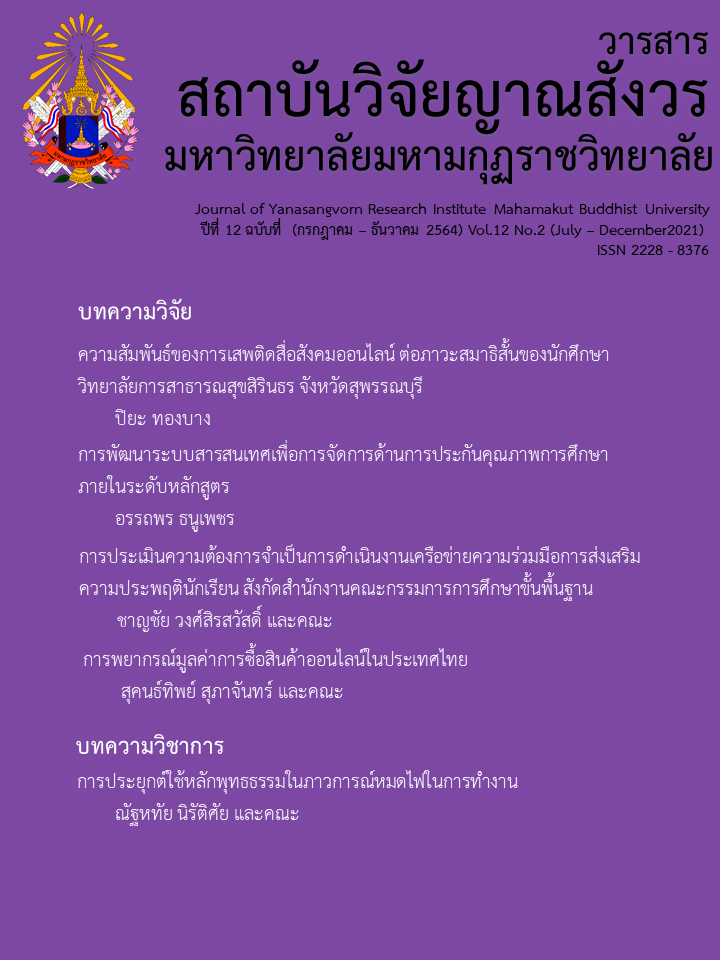APPLICATION OF BUDDHIST PRINCIPLES IN THE STATE OF WORK POWER OUTAGE
Main Article Content
Abstract
The vibe of working power outage is the changing vibe of the mind which results from the chronic stress from work. The cause may be from the shortage of the power in decision making in working independently, the unclear purposes in working, the ineffectiveness of teamwork or organization, the over-working loads, the lack of commander’s or organization’s supports, and working in routines. The attributes of the vibe of working power outage are namely emotional exhaustion, the loss of the power in the mind, the negative perception of one’s own working ability, and the lack of success in life.
The application of Buddhistic teachings with the vibe of working power outage may be questionable for many people. Actually, it can be easily applied with such fundamental Buddhistic teaching as the four paths of accomplishment, the four bases of social solidarity, and the five powers. In order to support good health at work, one can begin to adjust one’s own fundamental thoughts by applying the four paths of accomplishment as the teaching of success, the making of satisfaction at work, the pleasure and faith in working, the happiness with work, the diligence in working, the concentration on working, and the responsibility within work in order for the achievement in working.
Article Details
References
กมลพร วรรณฤทธิ์.(2564).สิ่งที่ควรรู้เกี่ยวกับ Burn Out Syndrome . สืบค้น 10 มกราคม 2564, .จาก https://www.si.mahidol.ac.th/th/healthdetail.asp?aid=1385.
กรมการแพทย์.(2562).รู้จักภาวะหมดไฟ BURN OUT. สืบค้นเมื่อ 8 กุมภาพันธ์ 2564 , จาก https://www.hfocus.org/content/2019/10/17916
ดาริกา ปิตุรงคพิทักษ์.(2554).การทดสอบแบบจำลองและความเหนื่อยหน่ายในการทำงานของไชรอม (วิทยานิพนธ์ปริญญามหาบัณฑิต). มหาวิทยาลัยธรรมศาสตร์, กรุงเทพมหานคร
นฤมล สุธีรวุฒิ.(2558).ภาวะหมดไฟ:ปัจจัยที่เกี่ยวข้องและแนวทางในการป้องกัน. วารสารการวัดผลการศึกษา, 32(91), 18 -19.
พรชัย สิทธิศรัณย์กุล.(2564). ภาวะหมดไฟในการทำงาน. สืบค้นเมื่อ 11 มกราคม 2564, จาก http://doh.hpc.go.th/bs/topicDisplay.php?id=273.
พระธรรมปิฎก (ป.อ.ปยุตฺโต).(2546). พจนานุกรมพุทธศาสตร์ ฉบับประมวลศัพท์ (พิมพ์ครั้งที่ 11)กรุงเทพมหานคร:มหาจุฬาลงกรณมหาวิทยาลัย.
ยงยุทธ แก้วเต็มและคณะ.(2562).แนวคิดทางพระพุทธศาสนา พละ 5 : การประยุกต์ใช้ในการพัฒนาการจัดการศึกษาเพื่อการเรียนรู้ของนักศึกษาพยาบาลในศตวรรษที่ 21 .วารสาร มจร สังคมศาสตร์ปริทรรศน์, 8(1), 5-7.
โรงพยาบาลจุฬาลงกรณ์ สภากาชาดไทย (2562) BURNOUT หมดไฟในการทำงาน ภาวะคุกคามคุณภาพชีวิตแห่งโลกยุคใหม่. สืบค้นเมื่อ 7กุมภาพันธ์ 256,จากhttps://www.chulaiongkornhospital.co.th.
วศิน อินทสระ.(2564). พละ 5 ในชีวิตประจำวัน . สืบค้นเมื่อ 7 กุมภาพันธ์ 2564, จากhttps://minimore.com/b/wRsxx/47.
สำนักงานกองทุนสนับสนุนการสร้างเสริมสุขภาพ. (2564) . หมดไฟในการทำงาน ภัยคุกคามชาวออฟฟิศ. สืบค้น 10 มกราคม 2564, จาก https://www.thaihealth.or.th
อโนทัย สุ่นสวัสดิ์ .(2564). Burn Out Syndrome อย่ารอให้หมดไฟในการทำงาน. สืบค้นเมื่อ 11 มกราคม 2564, จาก https://www.bangkokhospital.com/content/ burnout-syndrome.


